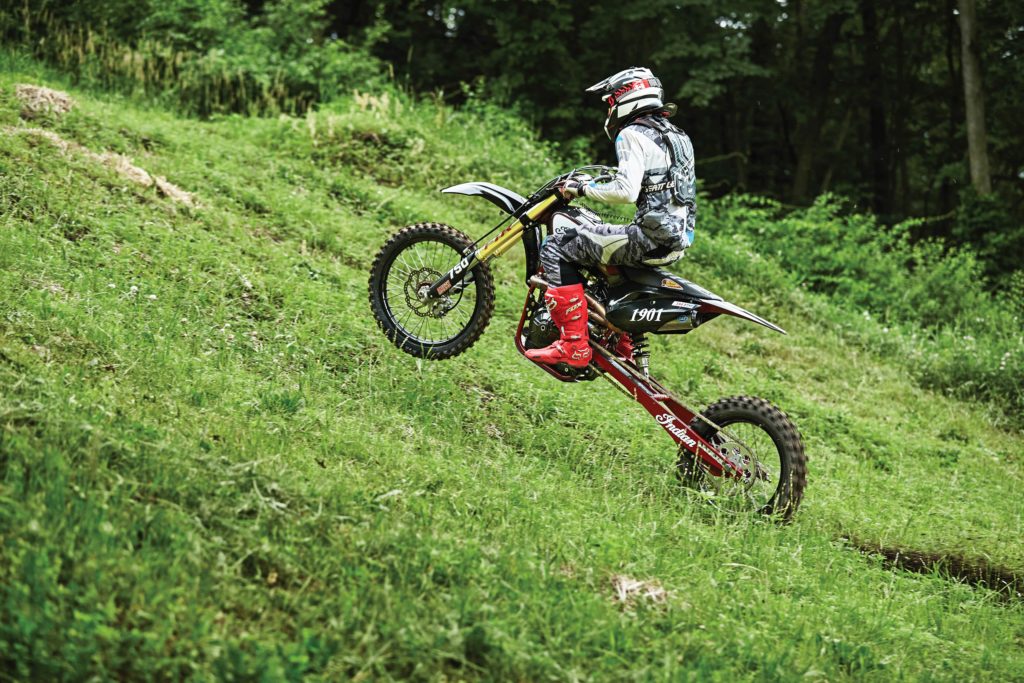
After an 80-year absence, Indian gets back into the wide-open, hill-climbing action with champion pilot John Koester
Words by Kali Kotoski
Photos courtesy of Indian Motorcycle
The premise behind hillclimb racing for the last 120 or so years has remained largely unchanged. Take the skull of a grassy or shrubby hill, let some rubber rip up a dark earthy vein, place a squadron of catchers partially rappelled down the face armed with hooks, while at the base of the hill, racers pin the throttle to make the rough ascent over the top. What happens next is either a rider conquers the climb and blasts out of sight with what appears to be remarkable ease, or a rider stalls midway, falling ass over tits backwards or being catapulted, ragdoll-like, over the bars as the catchers scramble to secure the bike from gaining damaging, gravity-powered momentum. Other times, riders just lose steam and slump over to the side like exhausted mules.
With most racers largely focused on obtaining absurd speeds around an oval dirt track, launching through burned rubber on a drag strip, taking to the sky in motocross or knee-dragging on asphalt, this Sisyphean discipline is often overlooked and underappreciated. In terms of racing, hillclimb could likely be explained as some dead philosopher once proclaimed: “The victory is in the struggle.” Or, simply, BRAAP BRAAP BRAAP.
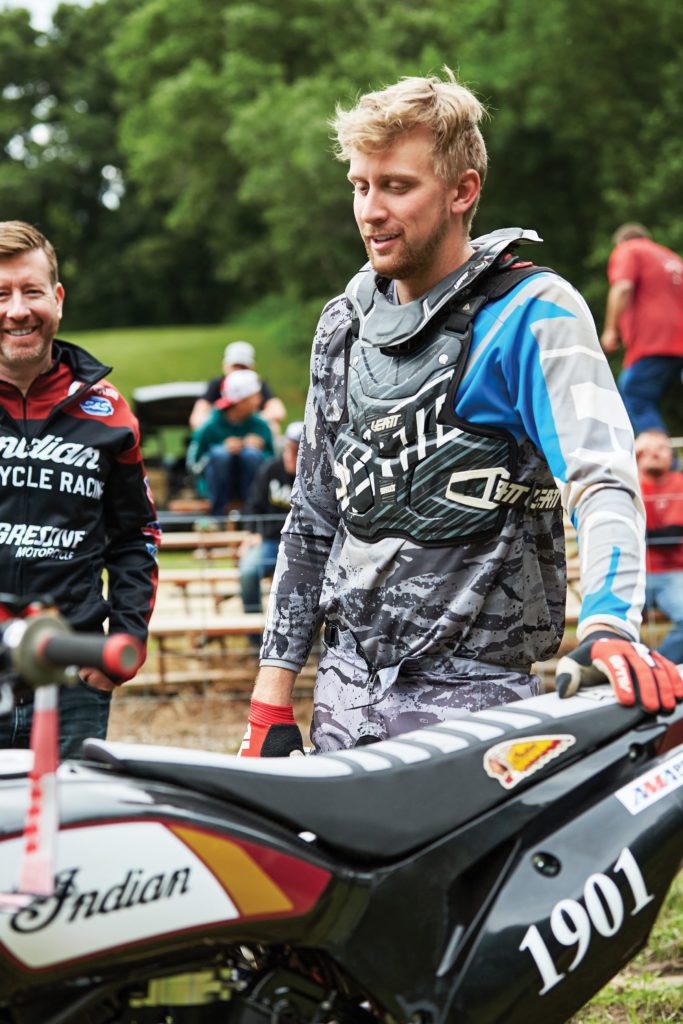
While hillclimb racing is not uniquely American, having been born in the late 1800s in the French Riviera, it certainly fits into America’s motorcycle ethos of being rogue pioneers. The first notable hillclimb activities were conducted by Indian Motorcycle in the early 1900s as an exciting marketing campaign to show onlookers the power of its latest motorcycle models.
Crowds would flock to the steepest hills in Springfield, Massachusetts to watch the Indian spectacle that eventually helped to inspire a new generation of thrill seekers. Manufacturers took notice and began producing hillclimb-specific bikes to satiate the rising popularity of the sport. Britain’s Triumph joined the fray in 1905 followed by Harley-Davidson.
Throughout the 1920s, the spectacle drew increasingly larger crowds after board track racing was largely banned over safety concerns. (See the August issue of Thunder Press for a deep dive into Don Ende’s book The Speed Kings about the rise and fall of the sport).
Some have even surmised that if it wasn’t for dedicated hillclimb and flat track racing operations, Indian and Harley-Davidson wouldn’t have been able to make it through the Great Depression.
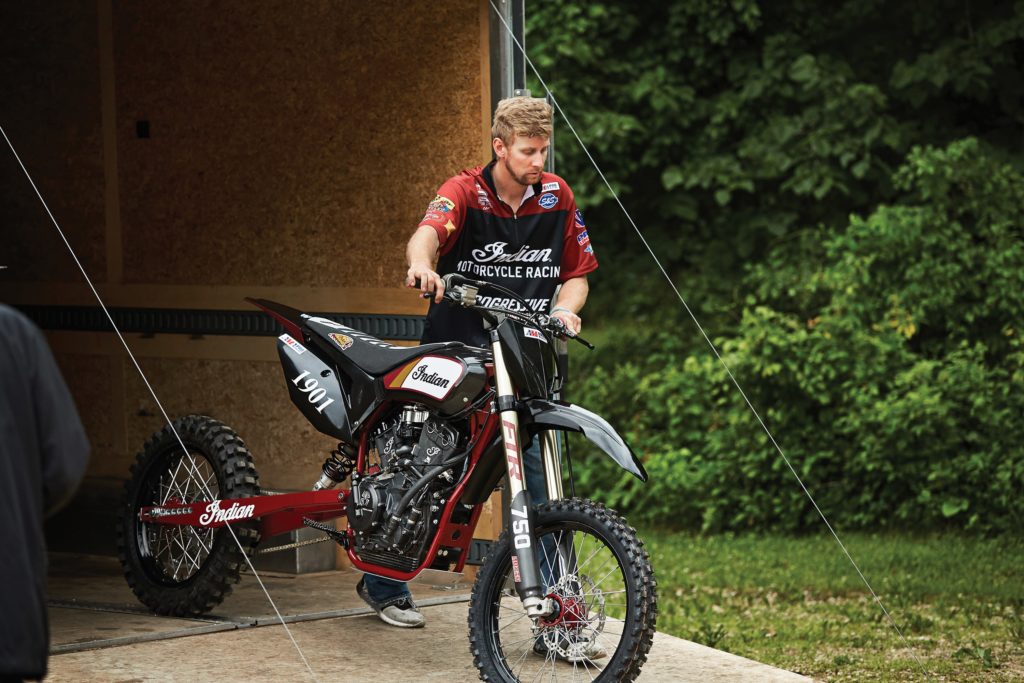


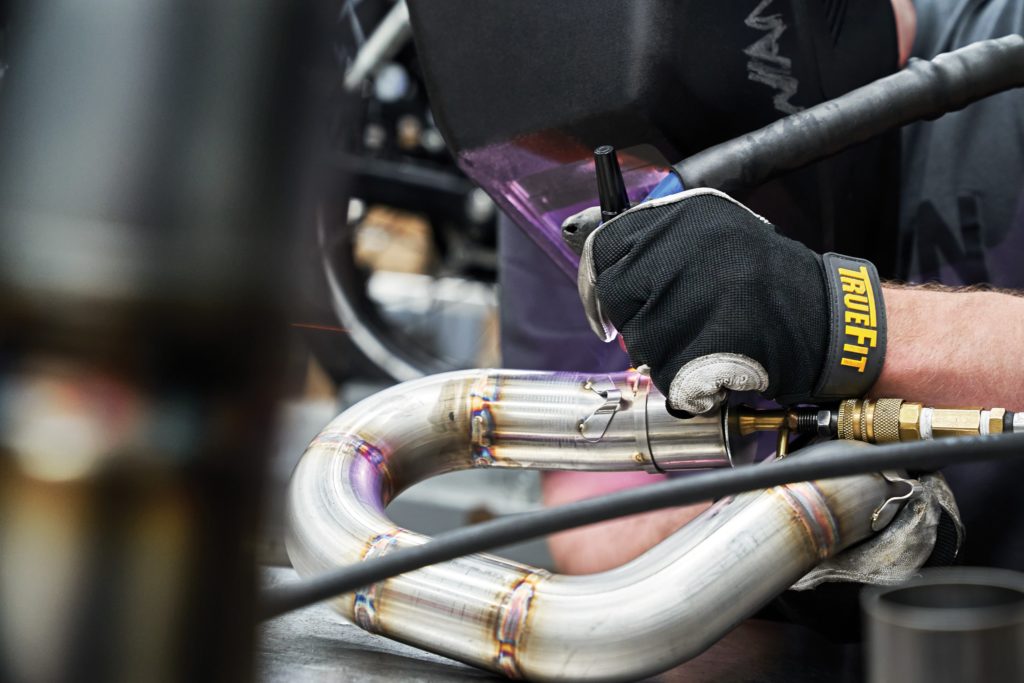
Now, nearly 80 years after Indian Motorcycle left the sport, it is returning to its roots and seeking to expand on its racing dominance the company’s machines have enjoyed in the dirt track arena. Sure, the racing has changed as speed and power increased with sanctioned events preferring lightly groomed wide tracks and hill jumps while still climbing hundreds and hundreds of feet at steep angles. But the sport remains a jaw-dropping exhibition of man mastering machine.
To lead its return, Indian has enlisted 10-time AMA Pro Hillclimb Champion John “Flyin” Koester to pilot a modified FTR750 in the series’ new Twin Class. Koester is regarded as one of the sport’s top riders, being the first U.S. rider to win three National AMA Pro Hillclimb titles in a single season. The move also signals Indian’s willingness and financial might to reach and invest in nearly all niches of the motorcycle universe.
But modifying the bike from a flat surface sprinter to the bumps and bruises of the hill wasn’t a straightforward process, Koester explained.
“The first thing everybody will notice is the long swingarm we added, which is necessary because it keeps the front wheel from lifting off the ground,” he said.
Koester, along with his father and crew chief Gordy Koester, spearheaded the transformation of the bike, which despite being aesthetically shocking, makes perfect mechanical sense for its treacherous application.
Together they built the swingarm and adapted it to the original FTR750 frame. Then they modified the steering neck to a motocross setup to provide more fork travel— a necessity to keep control while piloting up a hill and encountered unexpected divots and moguls.
Then they swapped out the steel subframe for an aluminum one.
“Other than that, everything is basically the same. But there were a lot of other tiny changes that the eye can’t see,” he said, not giving away race day secrets.

Koester owes a lot of his mechanical and racing success to his father, who has been his biggest supporter since he started competing at the age of 16.
“He has given me all the knowledge I have of motorcycles and he doesn’t get sick of me telling him what to do. We pick each other’s brain and we always find solutions,” he said.
When the plan for a hillclimb adaption of the FTR750 was first being hatched, the weight of a perceived traditional V-twin was a concern given the dominance of lightweight modified motocross bikes in competition.
“But when we got the bare frame and engine shipped to us a little after Christmas, I was surprised at how light the engine is. It is a very small motor for being as powerful as it is, especially seeing that I will be running against other guys with 1000cc bikes or bigger,” he said. “The engine has easily proven itself as more than capable on the dirt track,” he added.
After four months of tinkering and modifications, Koester has regularly been taking the bike out for practice runs during the offseason, which has extended because the pandemic has greatly scaled back the 2020 season. Races are currently scheduled for late September and mid-October.
When asked if that longer training period has helped, Koester said it was a mixed bag. Sure, he has gotten more time on the hill, but without the intensity of the competition, it is difficult to go all out.
“I have been trying to prepare as much as I can. It is just hard to put yourself in race mode, but we have been tinkering with the bike to make sure we stay on the top,” he said, adding that he is confident the FTR750 is dialed in.
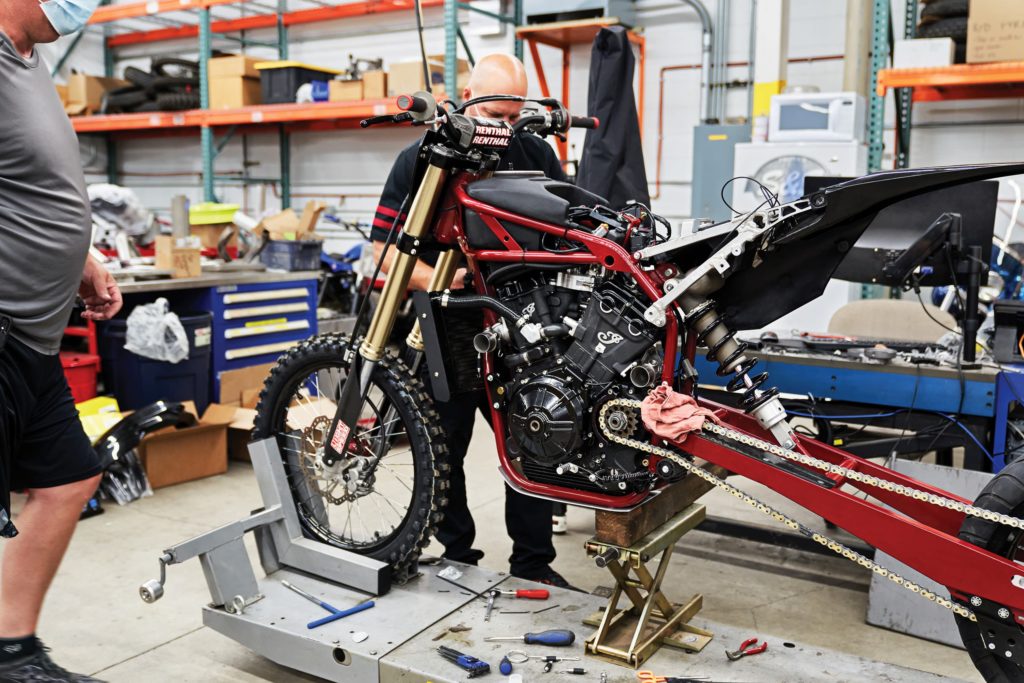
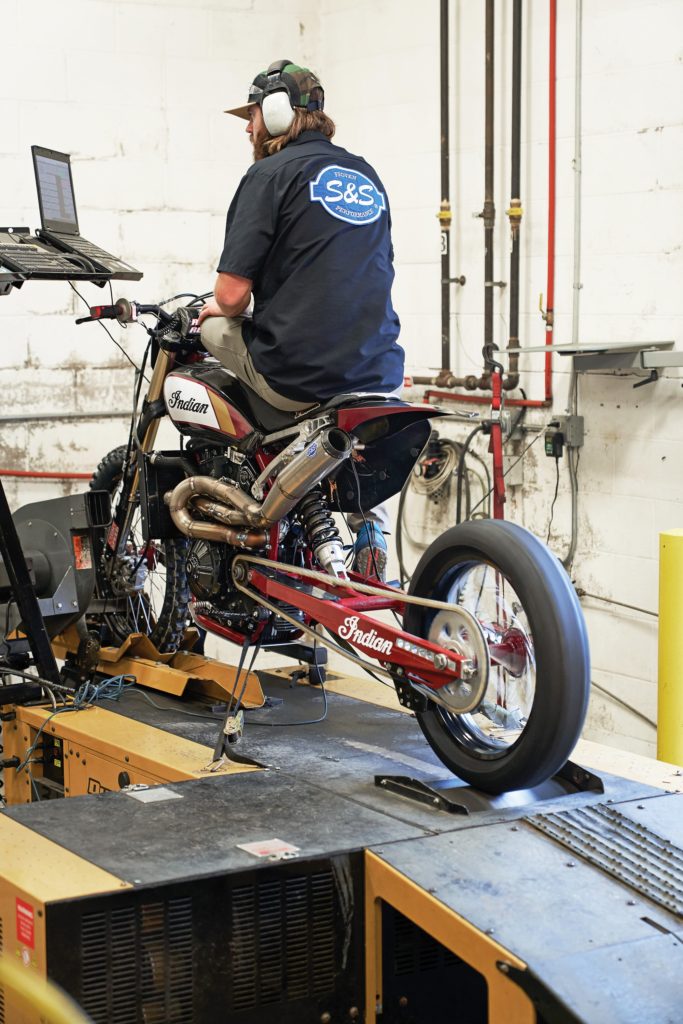
Koester admits his race strategy appears simple while underplaying the skill and athleticism needed to avoid getting a mouthful of dirt or taking an uncontrollable tumble.
“I really just try to go for it and not think too much,” he said. “You got guys standing on the hill for hours trying to pick out a line and by the time they actually race, that line isn’t even there anymore. So, really you just got to get on the throttle and go where the bike takes you and hope that is over the top.”
“I don’t want to say there is no strategy, but the strategy is to have faith in your equipment and hold it wide open,” he said.
With hillclimb racing being typically a hyper-localized event, drawing dedicated fans and very dedicated racers, Koester admits that since he became pro it has been difficult for the sport to gain national recognition on the scale of other motorcycle racing.
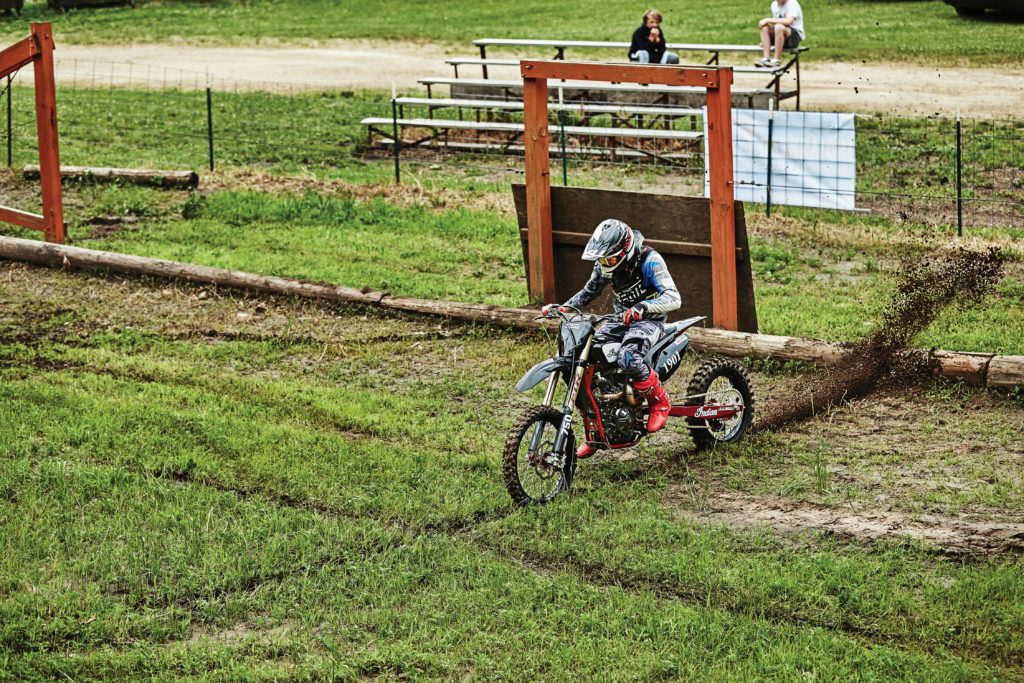

But he is confident that will change with Indian joining the mix and promoting events to its followers. He also feels that despite an 80-year hiatus from the sport, Indian has not skipped a beat as it returns to various forms of racing that made it famous over a hundred years ago.
“It is huge to have an OEM involved. It’s hard to get people interested because it is hard to explain a race that can last six seconds or 20 seconds, which is a blink of the eye compared to flat track,” he said. “So, it is colossal to have Indian in the series because we have been struggling for ten years to get recognition of what we do.”

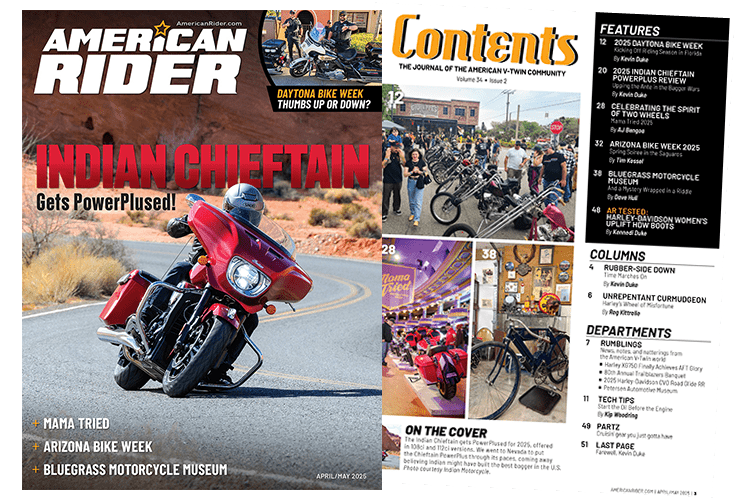

















Hill clime at poagshole in dansville ny 14437 is great .Nice ride,good crowd ,been around for 23 years now if the weather would behave